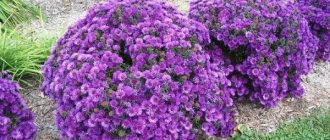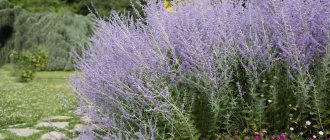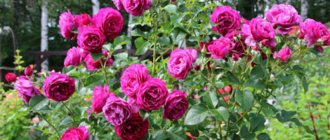Description of the Westerland variety
The Westerland variety is disease-resistant; the shrubs easily withstand attacks from parasites and are not infected with fungus. The plant is frost-resistant, it does not need to be covered for the winter; frost strengthens the “immunity” of the rose.
The crop blooms for a very long time, in several waves, in each of which many large flowers appear, flaunting on the stems until late autumn. The intervals between flowering are small, so the shrub rarely stands without buds.
| Color | Orange, light yellow, peach |
| Number of flowers per stem | 10/05/20 |
| Aroma | Strong |
| Flower size | 10-11 cm |
| Height | 160-200 cm |
| Width | 150 cm |
| Frost resistance | Frost-resistant, zone 5 |
| Powdery mildew resistance | Very good |
| Black spot resistance | Very good |
| Rain resistance | Medium, some flowers are damaged |
| Bloom | Continuously blooming |
| Bush shape | Climbing |
| Flower | Semidouble |
Appearance and features
The most beautiful period in the flowering of the Westerland rose is half-blown; at this time the flower looks neat and elegant, with a shape reminiscent of a classic rose.
A flower that has fully blossomed is fluffier, the petals are not densely packed, but they are large and wavy, which gives volume to the bud. The roses are moderately double, the number of petals in them does not exceed 25 pieces.
The color of the flowers is bright, summery and juicy. There are shrubs with rich orange buds or with more delicate peach flowers, the central petals of which are light yellow. Flowers in the shape of a deep bowl.
The Westerland Shrub is short for its variety. The bushes are wide with slender shoots, on which there are many exquisite flowers, burning like lights against the backdrop of lush light greenery. The leaves on the branches are large, complex in shape with pointed teeth along the edges. There are few thorns on the stems; they are small, but sharp.
Bright detail of the Westerland variety
Rose Westerland has a persistent aroma that spreads throughout the entire area. This property makes the variety especially attractive for growing in the garden. A crop with bright buds of salmon or peach color, its flexible and strong stems stretch high up or create a bizarre composition - it all depends on the gardener’s imagination and preferences.
Westerland - an original variety with large flowers and a heady aroma becomes a prominent representative of the shrub variety in the rose garden. There is an opinion that the light aroma of Westerland rose has a positive effect on a person’s condition, uplifting his mood and calming him down.
Park rose: planting a seedling (video)
Despite the fact that in central Russia the variety has shown good winter hardiness with sufficient snow cover, many gardeners still recommend using light shelter for the winter period. Rose Westerland has sufficient resistance to pathogenic microflora and adverse weather conditions, but grows and develops best in fertile and moist soils. The variety is widely used as a tapeworm, but can also be an excellent addition to various group plantings.
Diseases
Are there dark spots on the shoots of the rose? This could be necrosis, find out how to save the plant
Bark necrosis on roses
Does the rose begin to wither and die for no apparent reason? It could be root rot, find out control and prevention measures
Root rot of roses
Girdle spots of brick and burgundy shades appear on the shoots of roses, find out why this happens
Infectious rose burn
Are there growths and cracks on the rose? It could be cancer, read what to do next
Common rose cancer
Growing and caring for the Westerland rose
The Weserland rose variety is grown from seedlings; the crop will not grow from seeds. To become the owner of a strong, healthy shrub with full-flowering, bright buds, you need to plant the variety in certain conditions in compliance with the basic rules for its care.
Before planting a rose, you need to carefully inspect the seedling; there should be no diseased, infected or dried shoots on it. All damaged shoots must be removed without damaging the strongest stem.
In order for the roots to take root more successfully and be filled with nutrients, you can dip the roots of the seedling in a special solution that stimulates growth. The crop prefers loam, so add a little sand to clay soil, and add clay to sandy soil. The quality and fertility of the soil will be improved by humus, humus or phosphorus-based fertilizing.
For shrubs, dig a hole 50 cm deep, the distance between plants should be at least ½ meter. A ten-centimeter drainage of fine gravel is required at the bottom. It is advisable to put organic fertilizer on the drainage.
The roots placed in the hole must be carefully distributed over the entire area. The bush is covered with earth and compacted. Fresh plantings are hilled up and watered. The grafted area must be at least 3 cm under the soil.
It is advisable to water the Westerland rose in the morning before the midday solstice. Watering is done twice a week; in hot and dry periods this should be done more often. Water for irrigation should not be cold, but should stand for several hours. It is necessary to water at the root using a watering can without a sprinkler.
Nitrogen fertilizers are used as fertilizers in mid-spring and phosphorus-potassium fertilizers in early summer. It is not necessary to fertilize the crop from July, this way it is better prepared for the cold by accumulating vitamins and minerals for the whole winter. To ensure maximum flowering, you can feed the bush with superphosphate twice a month.
The first season the bush should not bloom, so it is pruned. Sanitary pruning is carried out in the spring before the buds appear; all diseased and dry shoots are removed from the rose. The variety tolerates replanting; this procedure is best done in the fall.
The crop can withstand moderate frosts; in regions with harsh winters, where the temperature drops below -30 degrees, it is necessary to cover the plant with spruce branches or special covering material.
The rose blooms continuously all summer until the first frost. The last flowers will delight their owner even in October. The plant will bloom successfully in suitable conditions. A variety may not produce flowers for several reasons: irregular watering, poor soil, incorrect choice of site where there is no periodic shading.
Flowering may be absent due to some disease that has affected the rose.
Plant propagation
There are two methods that are most common among gardeners: vegetative and cuttings.
When growing a flower using the vegetative method, the following sequence of actions is performed:
- At the beginning of spring, an adult plant is dug out of the ground and divided into several parts.
- On each of them, long roots and branches are removed.
- The roots are treated with a mixture of manure and clay.
- Then each new bush is planted in the ground using the standard method.
When cuttings proceed in the following sequence:
- In mid-summer, woody shoots are cut from the bush.
- The cuttings are treated with a growth stimulator and planted in a container at a distance of at least 5 cm from each other.
- To create a greenhouse effect, the container is covered with film.
- With proper care, the first shoots will appear in a month.
- Next spring, Western Land can be planted in open ground.
Options for using roses
The Westerland climbing rose grows widely, its many shoots covered with a large number of lush flowers. The plant looks impressive alone. You can use it to make a hedge or decorate a vertical surface.
Flexible branches take any shape well, so skilled gardeners trim the plant, giving the bush symmetrical rounded shapes that look unusual and well-groomed.
As neighbors, you can choose medium-sized plants with yellow or blue colors. Marigolds, Echinops, lavender, etc. are suitable. Westerland will become an original decoration for a balcony or canopy. The climbing appearance of the rose will decorate not only the landscape, but also the architectural structure.
Useful tips
- Neighbors such as marigolds, lavender, nasturtium and calendula not only create an excellent composition with Westerland, but also repel insects from it that are afraid of the pungent smell of these plants;
- For the first two weeks, the crop needs to be watered frequently, but only in the morning, so that the petals do not get burned by the midday sun;
- Especially high branches can break and must be tied to supports;
- If the plant is covered for the winter, then be sure to cut off the branches, water the soil and mulch it;
- If you plant a rose right next to a vertical support, it will very quickly climb onto it and begin to grow upward, creating a hedge with flowers;
- The Westerland rose does not like direct sunlight and wind, so it should be planted in shaded areas where there are no cold drafts.
Exchange of opinions of gardeners on growing Westerland roses in different climatic conditions
- Marina Genadieva, (Moscow region, zone 4)
Rose is 5 years old, I planted her to cover the ugly wall of the utility room. Over the years, the bush has completely coped with the task, growing by 4 m. It blooms in two stages from mid-June, for about a month, then, after a short pause, the rose is again covered with flowers. N
I don’t remove the support for the winter - there’s nowhere to put it, there’s a path nearby, so I just hill it up. Over the years, I have never seriously frozen. Wonderful rose.
- Valeria Andreevna (Zheleznogorsk, zone 5).
My "Westerland" in the amount of four bushes grows on the north-eastern side of the fence. The sun is there only in the morning and then not for long. And the rose blooms regularly all summer, sometimes thicker, sometimes less often, but until October.
- Ekaterina, (82 km southwest of St. Petersburg, zone 4).
It’s simply amazing how such a beauty can be so unpretentious, there’s no hassle with her.
- Lyudmila Konstantinovna, (Kursk, zone 5).
Last rainy summer took its toll on all the roses and Westerland too. The flowers did not have time to bloom, some buds withered without opening. Even for such a resistant variety there is a testing limit! The main thing is that the rose survived, unlike some other varieties.
Pros and cons of the Westerland variety
Advantages:
- Unusual decoration of a landscape or architectural structure;
- Resistant to diseases and parasites;
- Tolerates frosty winters;
- Combines with different types of plants;
- It has a distinct aroma that lifts your spirits;
- Lush continuous flowering and rich succulent foliage.
Flaws:
- Excessively rapid growth of fragile branches that break from strong gusts of wind;
- In rainy weather, the rose may bloom poorly or even die.
Why doesn't the rose bloom?
- The plant is too young (first year of planting).
- Lack of sunlight. Roses are native to the southern regions, and for full development and lush flowering they must receive sunlight at least 8 hours a day.
- The presence of drafts and constantly blowing winds. All roses are heat-loving, so the planting site should be protected from wind and drafts.
- Unsuitable soils. Roses love nutritious, moisture-permeable and breathable soil. They will not bloom on thin soils and with high groundwater levels.
- Presence of a competing plant nearby. Roses receive few nutrients, they grow and bloom poorly.
- Excessive pruning.
- Lack of fertilizing or improper application of fertilizers. Fertilizing must be balanced in composition, applied at certain periods and in the required concentration.
- The presence of root shoots of the rootstock. Sometimes the rootstock (most often rose hips) produces shoots that begin to suppress the grafted variety, depriving the rose of nutrients, moisture and light. To prevent their germination, when planting, the grafting site should be buried to a sufficient depth.
- Bacterial burn. It occurs after wintering roses. Damaged shoots must be removed radically immediately after removing the cover.
- Aging of a rose. Old plants stop blooming or produce single flowers. Roses older than 3 years need to be rejuvenated by cutting out old, very woody shoots. In their place, new branches will appear, producing abundant flowering.
We suggest you read: Do pigs eat pork?











